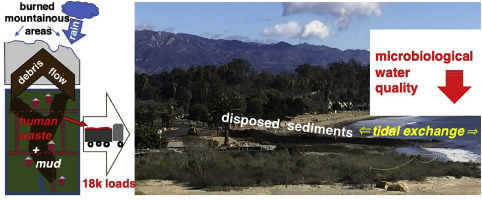当前位置:
X-MOL 学术
›
Water Res.
›
论文详情
Our official English website, www.x-mol.net, welcomes your feedback! (Note: you will need to create a separate account there.)
Surf zone microbiological water quality following emergency beach nourishment using sediments from a catastrophic debris flow.
Water Research ( IF 12.8 ) Pub Date : 2020-03-18 , DOI: 10.1016/j.watres.2020.115733 Dong Li 1 , Laurie C Van De Werfhorst 1 , Thomas Dunne 1 , Naresh Devarajan 1 , Tania Gomez Ayala 1 , Patricia A Holden 1
Water Research ( IF 12.8 ) Pub Date : 2020-03-18 , DOI: 10.1016/j.watres.2020.115733 Dong Li 1 , Laurie C Van De Werfhorst 1 , Thomas Dunne 1 , Naresh Devarajan 1 , Tania Gomez Ayala 1 , Patricia A Holden 1
Affiliation

|
Urban disaster response requires disposal of complex wastes. This study regards a case wherein high intensity rainfall fell over a remote mountainous area previously burned by wildfire, generating debris flows that devastated a downstream town. Sanitary sewers and homes with septic systems were damaged, releasing human waste into the debris flow field. Contaminated sediments, with their high fecal indicator bacteria (FIB) concentrations, were cleared from public rights-of-way and creek channels by local authorities, then disposed onto distant Goleta Beach for beach nourishment, causing immediate surf zone microbiological water quality exceedances. To determine potential public health threats, disposed sediments and surf zone waters were sampled and analyzed-relative to reference samples of mountain soil and raw sewage-for FIB, pathogens, human (HF183) and other host- (Gull2 TaqMan, and DogBact) associated DNA-based fecal markers, and bacterial community 16S rRNA gene sequences. Approximately 20% of disposed sediment samples contained the HF183 marker; sequencing suggested that all samples were contaminated by sewage. In an initial sediment disposal period, surf zone waters harbored intestinal bacterial sequences that were shared with disposed sediments and sewage. Yet surf zone bacterial communities returned to mostly marine clades within weeks. Taken together, multiple conventional and DNA-based analyses informed this forensic assessment of human waste contamination. In the future, similar analyses could be used earlier in disaster response to guide sediment disposal decisions towards continuously protecting beachgoer health.
中文翻译:

使用来自灾难性泥石流的沉积物对海滩进行紧急营养后,冲浪区微生物水质。
应对城市灾害需要处理复杂的废物。这项研究以高强度降雨落在先前因野火烧毁的偏远山区而产生的泥石流摧毁了下游城镇的情况为例。带有化粪池系统的下水道和房屋遭到破坏,将人类废物释放到泥石流场中。粪便指示菌(FIB)浓度高的受污染沉积物已被地方当局从公共通行权和小河通道清除,然后丢弃到遥远的Goleta海滩上进行海滩营养,导致冲浪区微生物水质立即超标。为了确定潜在的公共卫生威胁,对处置的沉积物和冲浪区水进行了采样并进行了分析(相对于山地土壤和原污水的参考样品)-FIB,病原体,人类(HF183)和其他宿主(Gull2 TaqMan和DogBact)相关的基于粪便的DNA标记,以及细菌群落16S rRNA基因序列。约有20%的沉积物样本含有HF183标记;测序表明所有样品均被污水污染。在最初的沉积物处置期中,冲浪区水域含有与处置的沉积物和污水共享的肠道细菌序列。然而,冲浪区细菌群落在数周内恢复了大部分海洋进化枝。综合起来,多种常规分析和基于DNA的分析为对人类废物污染的法医评估提供了依据。将来,类似的分析可能会更早地用于灾害响应中,以指导沉积物处置决策,从而继续保护泳客的健康。和DogBact)相关的基于DNA的粪便标记,以及细菌群落16S rRNA基因序列。约有20%的沉积物样本含有HF183标记;测序表明所有样品均被污水污染。在最初的沉积物处置期中,冲浪区水域含有与处置的沉积物和污水共享的肠道细菌序列。然而,冲浪区细菌群落在几周内恢复了大部分海洋进化枝。综合起来,多种常规分析和基于DNA的分析为对人类废物污染的法医评估提供了依据。将来,类似的分析可能会更早地用于灾害响应中,以指导沉积物处置决策,从而继续保护泳客健康。和DogBact)相关的基于DNA的粪便标记,以及细菌群落16S rRNA基因序列。约有20%的沉积物样本含有HF183标记;测序表明所有样品均被污水污染。在最初的沉积物处置期中,冲浪区水域含有与处置的沉积物和污水共享的肠道细菌序列。然而,冲浪区细菌群落在几周内恢复了大部分海洋进化枝。综合起来,多种常规分析和基于DNA的分析为对人类废物污染的法医评估提供了依据。将来,类似的分析可能会更早地用于灾害响应中,以指导沉积物处置决策,从而继续保护泳客健康。约有20%的沉积物样本含有HF183标记;测序表明所有样品均被污水污染。在最初的沉积物处置期中,冲浪区水域含有与处置的沉积物和污水共享的肠道细菌序列。然而,冲浪区细菌群落在几周内恢复了大部分海洋进化枝。综合起来,多种常规分析和基于DNA的分析为对人类废物污染的法医评估提供了依据。将来,类似的分析可能会更早地用于灾害响应中,以指导沉积物处置决策,从而继续保护泳客健康。约有20%的沉积物样本含有HF183标记;测序表明所有样品均被污水污染。在最初的沉积物处置期中,冲浪区水域含有与处置的沉积物和污水共享的肠道细菌序列。然而,冲浪区细菌群落在几周内恢复了大部分海洋进化枝。综合起来,多种常规分析和基于DNA的分析为对人类废物污染的法医评估提供了依据。将来,类似的分析可能会更早地用于灾害响应中,以指导沉积物处置决策,从而继续保护泳客的健康。冲浪区水域的肠道细菌序列与处置的沉积物和污水共享。然而,冲浪区细菌群落在数周内恢复了大部分海洋进化枝。综合起来,多种常规分析和基于DNA的分析为对人类废物污染的法医评估提供了依据。将来,类似的分析可能会更早地用于灾害响应中,以指导沉积物处置决策,从而继续保护泳客的健康。冲浪区水域的肠道细菌序列与处置的沉积物和污水共享。然而,冲浪区细菌群落在几周内恢复了大部分海洋进化枝。综合起来,多种常规分析和基于DNA的分析为对人类废物污染的法医评估提供了依据。将来,类似的分析可能会更早地用于灾害响应中,以指导沉积物处置决策,从而继续保护泳客健康。
更新日期:2020-03-19
中文翻译:

使用来自灾难性泥石流的沉积物对海滩进行紧急营养后,冲浪区微生物水质。
应对城市灾害需要处理复杂的废物。这项研究以高强度降雨落在先前因野火烧毁的偏远山区而产生的泥石流摧毁了下游城镇的情况为例。带有化粪池系统的下水道和房屋遭到破坏,将人类废物释放到泥石流场中。粪便指示菌(FIB)浓度高的受污染沉积物已被地方当局从公共通行权和小河通道清除,然后丢弃到遥远的Goleta海滩上进行海滩营养,导致冲浪区微生物水质立即超标。为了确定潜在的公共卫生威胁,对处置的沉积物和冲浪区水进行了采样并进行了分析(相对于山地土壤和原污水的参考样品)-FIB,病原体,人类(HF183)和其他宿主(Gull2 TaqMan和DogBact)相关的基于粪便的DNA标记,以及细菌群落16S rRNA基因序列。约有20%的沉积物样本含有HF183标记;测序表明所有样品均被污水污染。在最初的沉积物处置期中,冲浪区水域含有与处置的沉积物和污水共享的肠道细菌序列。然而,冲浪区细菌群落在数周内恢复了大部分海洋进化枝。综合起来,多种常规分析和基于DNA的分析为对人类废物污染的法医评估提供了依据。将来,类似的分析可能会更早地用于灾害响应中,以指导沉积物处置决策,从而继续保护泳客的健康。和DogBact)相关的基于DNA的粪便标记,以及细菌群落16S rRNA基因序列。约有20%的沉积物样本含有HF183标记;测序表明所有样品均被污水污染。在最初的沉积物处置期中,冲浪区水域含有与处置的沉积物和污水共享的肠道细菌序列。然而,冲浪区细菌群落在几周内恢复了大部分海洋进化枝。综合起来,多种常规分析和基于DNA的分析为对人类废物污染的法医评估提供了依据。将来,类似的分析可能会更早地用于灾害响应中,以指导沉积物处置决策,从而继续保护泳客健康。和DogBact)相关的基于DNA的粪便标记,以及细菌群落16S rRNA基因序列。约有20%的沉积物样本含有HF183标记;测序表明所有样品均被污水污染。在最初的沉积物处置期中,冲浪区水域含有与处置的沉积物和污水共享的肠道细菌序列。然而,冲浪区细菌群落在几周内恢复了大部分海洋进化枝。综合起来,多种常规分析和基于DNA的分析为对人类废物污染的法医评估提供了依据。将来,类似的分析可能会更早地用于灾害响应中,以指导沉积物处置决策,从而继续保护泳客健康。约有20%的沉积物样本含有HF183标记;测序表明所有样品均被污水污染。在最初的沉积物处置期中,冲浪区水域含有与处置的沉积物和污水共享的肠道细菌序列。然而,冲浪区细菌群落在几周内恢复了大部分海洋进化枝。综合起来,多种常规分析和基于DNA的分析为对人类废物污染的法医评估提供了依据。将来,类似的分析可能会更早地用于灾害响应中,以指导沉积物处置决策,从而继续保护泳客健康。约有20%的沉积物样本含有HF183标记;测序表明所有样品均被污水污染。在最初的沉积物处置期中,冲浪区水域含有与处置的沉积物和污水共享的肠道细菌序列。然而,冲浪区细菌群落在几周内恢复了大部分海洋进化枝。综合起来,多种常规分析和基于DNA的分析为对人类废物污染的法医评估提供了依据。将来,类似的分析可能会更早地用于灾害响应中,以指导沉积物处置决策,从而继续保护泳客的健康。冲浪区水域的肠道细菌序列与处置的沉积物和污水共享。然而,冲浪区细菌群落在数周内恢复了大部分海洋进化枝。综合起来,多种常规分析和基于DNA的分析为对人类废物污染的法医评估提供了依据。将来,类似的分析可能会更早地用于灾害响应中,以指导沉积物处置决策,从而继续保护泳客的健康。冲浪区水域的肠道细菌序列与处置的沉积物和污水共享。然而,冲浪区细菌群落在几周内恢复了大部分海洋进化枝。综合起来,多种常规分析和基于DNA的分析为对人类废物污染的法医评估提供了依据。将来,类似的分析可能会更早地用于灾害响应中,以指导沉积物处置决策,从而继续保护泳客健康。

























 京公网安备 11010802027423号
京公网安备 11010802027423号